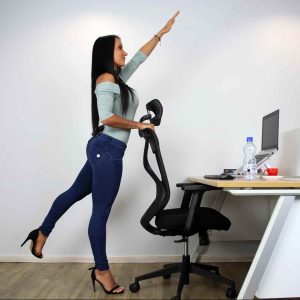
Unveiling the True Cost of Ergonomic Office Chairs: Are they Worth the Investment?
Although the upfront cost of ergonomic office chairs may seem high, over their lifespan they are a low-cost and smart investment.
Ask yourself….“Am I sitting too much?” The answer is “probably”. In a world where many people work in confined seating for most of the time, the discomfort and lack of movement is a silent killer. Research over the years has highlighted the health risks of sitting too long at a desk or workstation, often all day, and they include lower back, neck and hip pain. How Ergonomic Chairs Transformed My Work Life – My Journey with Nerve Pain in My Lower Back
From an article in The Conversation in 2017, we see the awful effects. “Over the past 15 years or so, sitting has been linked to cancer, heart disease and diabetes and even depression. This has led to a surge in media stories on the risks of sitting, even for people who do a lot of exercise.” A study published in the Annals of Internal Medicine in 2017, confirmed that sitting for excessively long periods of time is a risk factor for early death.
Do you suffer from:
If the answer is “YES”, then the chances are that you ARE sitting too much!
There are several ways that you can reduce the negative health risks of sitting too long and possibly prevent burnout. They are all doable, sustainable, and incredibly critical to ensuring your desk job doesn’t follow the hyperbole and actually kill you.
Taking a movement break every 30-40 minutes at work can stave off the office-chair effect and prevent many negative impacts that are caused by eight hours of immobility. Improve the health of your heart by taking a walk, stretching, or getting some fresh air on a regular basis. There are simple exercises and stretches that you can do at work to reduce the health risks of sitting at your desk all day. These exercises and stretches will help prevent back, hip, neck and other pains commonly caused by sitting too long.
Doing 45 to 60 minutes of exercise, four to five times per week is recommended for adults as the goal for optimum health.
With overwhelming data that supports exercise as the number one solution, how do we ensure that when we work, we aren’t undoing all our hard work?
As noted by Zack Arnold on his site Optimize Yourself, being sedentary is the killer – whether you’re sitting, standing, or lying on a bench at the gym. Keeping your full range of motion is critical. He adds, “Sitting is more dangerous than smoking, kills more people than HIV and is more treacherous than parachuting. We are sitting ourselves to death.”
Even though we can’t all go for half-hourly walks, it’s possible to keep your body in tip-top condition by allowing free movement and back-support in the assumed work-position. That’s why you should be unrestricted, mobile, and comfortable in your office chair.
Luckily, this area is one in which extensive research and legwork have been done to ensure that ergonomic, supporting office chairs, are readily available.

A good ergonomic office chair will ensure that your posture and sitting position is not damaging your body. Adjusting your chair correctly is the basis of a good sitting posture. Get your body comfortable. How do I choose the right ergonomic desk chair for me? Reduce the strain from chair-related discomfort and so improve your concentration, accuracy, and overall productivity. The Latest Trends in selecting a Comfortable Office Chair.
Protect your back!




Your office chair can, and does make a difference! Reduce the physical and mental health risks of sitting by investing in an ergonomic office chair. Can Ergonomic Chairs Help with Sciatica and Pinched Nerves? Doing so can prevent lower back, hip, neck and other pain caused by sitting too long. Protect your health….it’s worth it!

Although the upfront cost of ergonomic office chairs may seem high, over their lifespan they are a low-cost and smart investment.

Leather, Bonded Leather or Faux Leather Office Chair?
There are big differences between the types of leather used for office chairs.

Improve concentration and wellbeing while reducing stress.


